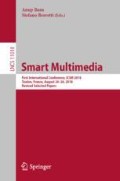Abstract
This paper introduces the development of exercises to be embedded in a lightweight laparoscopic haptic simulator to help surgeons starting their training to Minimal Invasive Surgery (MIS) gestures. These exercises were created by observing professionals in operation rooms and by isolating key gestures, which have been combined to create desired trajectories with a slow learning curve. These exercises combine memory, new gestures, new environments and new visual feedback so that the trainees’ cognitive load remains low. This favors an effective training. Hence, the simulator displays a simple 3D virtual environment in order to focus on the gestures and trajectories, performed on an haptic device by means of real MIS tool handles. Its ludic dimension, which make it a Serious Game, should help users to make progress in their first gesture training in order to continue on more evolved medical simulators. This paper introduces the software architecture analysis and the methods used for creating the exercises.
Access this chapter
Tax calculation will be finalised at checkout
Purchases are for personal use only
Notes
- 1.
See http://www.ros.org/.
- 2.
- 3.
SDF: Simulator Description Format.
- 4.
- 5.
OpenGL (Open Graphics Library) is cross-platform API for rendering 2D and 3D graphics.
- 6.
GLUT (OpenGL Utility Toolkit) is a library of utilities for OpenGL used for system-level I/O.
References
Chaudhry, A., Sutton, C., Wood, J., Stone, R., McCloy, R.: Learning rate for laparoscopic surgical skills on MIST VR, a virtual reality simulator: quality of human-computer interface. Ann. R. Coll. Surg. Engl. 81(4), 281 (1999)
Cifuentes, J., Boulanger, P., Pham, M.T., Moreau, R., Prieto, F.: Automatic gesture analysis using constant affine velocity. In: Engineering in Medicine and Biology Society (EMBC), 2014 36th Annual International Conference of the IEEE, pp. 1826–1829. IEEE (2014)
Fried, G.M.: FLS assessment of competency using simulated laparoscopic tasks. J. Gastrointest. Surg. 12(2), 210–212 (2008)
Hyltander, A., Liljegren, E., Rhodin, P.H., Lönroth, H.: The transfer of basic skills learned in a laparoscopic simulator to the operating room. Surg. Endosc. 16(9), 1324–1328 (2002)
James, D.L., Pai, D.K.: DyRT: dynamic response textures for real time deformation simulation with graphics hardware. In: ACM Transactions on Graphics (TOG), vol. 21, no. 3, pp. 582–585. ACM (2002)
Julian, D., Tanaka, A., Mattingly, P., Truong, M., Perez, M., Smith, R.: A comparative analysis and guide to virtual reality robotic surgical simulators. Int. J. Med. Robot. Comput. Assist. Surg. 14(1), e1874-n/a, e1874 RCS-17-0115.R2 (2018)
Panait, L., Akkary, E., Bell, R.L., Roberts, K.E., Dudrick, S.J., Duffy, A.J.: The role of haptic feedback in laparoscopic simulation training. J. Surg. Res. 156(2), 312–316 (2009)
Van Merriënboer, J.J.G., Sweller, J.: Cognitive load theory in health professional education: design principles and strategies. Med. Educ. 44(1), 85–93 (2010)
Westwood, J.D., Hoffman, H.M., Stredney, D., Weghorst, S.J.: Validation of virtual reality to teach and assess psychomotor skills in laparoscopic surgery: results from randomised controlled studies using the MIST VR laparoscopic simulator. In: Medicine Meets Virtual Reality: Art, Science, Technology: Healthcare and Evolution, p. 124 (1998)
Woodrum, D.T., Andreatta, P.B., Yellamanchilli, R.K., Feryus, L., Gauger, P.G., Minter, R.M.: Construct validity of the LapSim laparoscopic surgical simulator. Am. J. Surg. 191(1), 28–32 (2006)
Acknowledgements
Authors would like to thank the University of Ottawa SIRI program which helped Nemanja Babic realize this work during his internship in Ampere lab in Lyon.
Author information
Authors and Affiliations
Corresponding author
Editor information
Editors and Affiliations
Rights and permissions
Copyright information
© 2018 Springer Nature Switzerland AG
About this paper
Cite this paper
Babic, N. et al. (2018). Haptic Training in a Virtual Environment to Train Cognitive Functions of Medical Students: Work in Progress. In: Basu, A., Berretti, S. (eds) Smart Multimedia. ICSM 2018. Lecture Notes in Computer Science(), vol 11010. Springer, Cham. https://doi.org/10.1007/978-3-030-04375-9_10
Download citation
DOI: https://doi.org/10.1007/978-3-030-04375-9_10
Published:
Publisher Name: Springer, Cham
Print ISBN: 978-3-030-04374-2
Online ISBN: 978-3-030-04375-9
eBook Packages: Computer ScienceComputer Science (R0)

